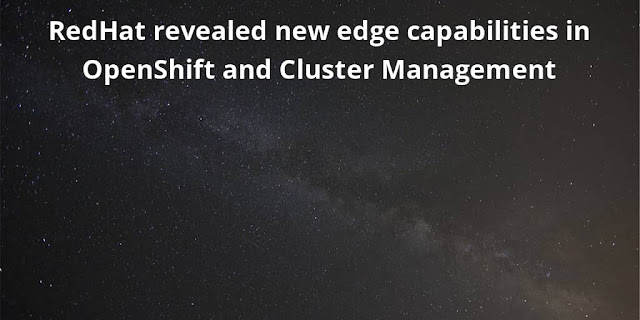Red Hat revealed new Edge Capabilities in OpenShift and Advanced Cluster Management
Red Hat has now revealed newer updated versions of the Red Hat OpenShift and Red Hat Cluster Advanced Cluster Management for Kubernetes.
OpenShift is a cloud-based open-source platform as a service solution. It is aimed at developed to build and deploy apps on the cloud. It allows for deployment onto the public-facing web apps, backend apps, or microservices architectures.
Executive Opinion
Stefanie Chiras, senior vice president, Platforms Business Group, Red Hat, said, "Edge computing is fundamentally changing how businesses are using and interacting with data and, as edge use cases grow exponentially, consistency is imperative to managing the scale of these distributed workloads and infrastructure. The new capabilities in Red Hat OpenShift and Red Hat Advanced Cluster Management help further extend what the open hybrid cloud is capable of - providing a common foundation for innovation from on-premises datacenters to the furthest reaches of enterprise networks."
Dennis Gatens, CEO and president, LEOcloud, said, "Red Hat OpenShift will allow us to speed up processing of satellite-sourced data at our Space Edge cloud facilities for our customer’s business critical applications, while reducing latency and data transport costs. And, single node OpenShift is the perfect container platform for our Space Edge LEO constellation of satellite data centers. It allows customers to seamlessly move their applications from a terrestrial cloud environment to a LEOcloud satellite. Single node OpenShift will accelerate the deployment of applications to space where mission critical data can be analyzed as close as possible to the sources and users of data."
Red Hat Cluster Advanced Cluster Management for Kubernetes
Apart from that, Red Hat Advanced Cluster Management is a console that helps clusters and apps on a single platform. So, here cluster refers to a group of desktops, servers, data centers, and some other resources that at as a single system.
The new capabilities will include the general availability of the OpenShift for enterprise Kubernetes Clusters, which is even expected to help developers expand existing deployment, development, and management workflows.
The OpenShift version 4.9 and Red Hat Advanced Cluster Management version 2.4 will going to help improve the flexibility and management capabilities needed to deploy workloads wherever it needs to run.
Apart from that, hub side policy templating will reduce the number of policies for high scale management, while a zero-touch provisioning feature will help with the assisted installation on on-premise systems, helping with the complexities of higher scale cluster deployments.
PC: Pablo, Pixabay
Never miss an update. Subscribe and follow to stay informed. Delivered Every Tuesday.
We hate spam too, we will never share your details.

Udit Agarwal
Opinions expressed by techsutram contributors are their own. More details
Udit Agarwal is a Digital Marketer and a Content Marketing Specialist, He enjoys technical as well as non-technical writing. His passion and urge for gaining new insights on gadgets, smartphones and technology has led him to Techsutram. He quenches his thirst for technology through his action oriented writing skills and a profound ability to stay up to date with latest industry trends.
Weekly Newsletter
Never miss an update. Subscribe and follow to stay informed.
Delivered Every Tuesday.
Delivered Every Tuesday.
Thank you! You have successfully subscribed to our newsletter.
We hate spam too, we will never share your details.






No comments:
Post a Comment
Your valuable comments are welcome. (Moderated)